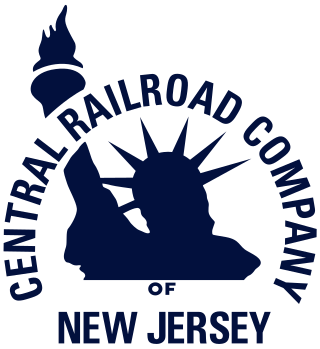
The Reading Company was a Philadelphia-headquartered railroad that provided passenger and freight transport in eastern Pennsylvania and neighboring states from 1924 until its acquisition by Conrail in 1976.

The Central Railroad of New Jersey, also known as the Jersey Central, Jersey Central Lines or New Jersey Central, was a Class I railroad with origins in the 1830s. It was absorbed into Conrail in April 1976 along with several other prominent bankrupt railroads of the Northeastern United States.
Conrail Shared Assets Operations (CSAO) is the commonly used name for modern-day Conrail, an American railroad company. It operates three networks, the North Jersey, South Jersey/Philadelphia, and Detroit Shared Assets Areas, where it serves as a contract local carrier and switching company for its owners, CSX Transportation and the Norfolk Southern Railway. When most of the former Conrail's track was split between these two railroads, the three shared assets areas were kept separate to avoid giving one railroad an advantage in those areas. The company operates using its own employees and infrastructure but owns no equipment outside MOW equipment.

The Mercer and Somerset Railway was a short-lived line of the Pennsylvania Railroad in western New Jersey, built to delay completion of the Delaware and Bound Brook Railroad, part of the National Railway line from Philadelphia, Pennsylvania to New York City.
The Philadelphia and Trenton Railroad was a railroad from Philadelphia, Pennsylvania to Trenton, New Jersey. Opened in 1832, it became part of the Pennsylvania Railroad system in 1871. The majority of it is now part of Amtrak's Northeast Corridor.
The United New Jersey Railroad and Canal Company (UNJ&CC) was a United States–based railroad company established in 1872. It was formed by the consolidation of three existing companies: the Camden and Amboy Railroad, Delaware and Raritan Canal Company, and New Jersey Rail Road and Transportation Company. The Camden and Amboy and New Jersey Rail Road were among the earliest North American railroads. The Pennsylvania Railroad leased the United New Jersey Railroad and Canal Company in 1872.

The SEPTA Regional Rail system is a commuter rail network owned by SEPTA and serving the Philadelphia metropolitan area. The system has 13 branches and more than 150 active stations in Philadelphia, Pennsylvania, its suburbs and satellite towns and cities. It is the sixth-busiest commuter railroad in the United States. In 2016, the Regional Rail system had an average of 132,000 daily riders and 118,800 daily riders as of 2019.
The National Railway or National Air Line Railroad was a planned air-line railroad between New York City and Washington, D.C. in the United States around 1870. Part of it was eventually built from New York City to Philadelphia by the Delaware and Bound Brook Railroad and the Delaware River Branch of the North Pennsylvania Railroad, leased by the Philadelphia and Reading Railway, in 1879, and becoming its New York Branch. The line was intended to provide an alternate to the various monopolies that existed along the route, specifically the United New Jersey Railroad and Canal Companies and their Camden and Amboy Railroad, and as such had a long struggle to be built.

Philadelphia was an early railroad hub, with lines from all over meeting in Philadelphia. The first railroad in Philadelphia was the Philadelphia, Germantown and Norristown Railroad, opened in 1832 north to Germantown. At the end of 1833, the state-built Philadelphia and Columbia Railroad, part of the Main Line of Public Works, opened for travel to the west, built to avoid loss of travel through Pennsylvania due to projects such as the Erie Canal. At the same time, the north-south leg of the Philadelphia City Railroad opened, running south along Broad Street from the Philadelphia and Columbia.

North Broad station, known as North Broad Street until 1992, is a SEPTA Regional Rail station in Philadelphia, Pennsylvania. It is located at 2601 North Broad Street in the Cecil B. Moore section of Lower North Philadelphia, and serves the Lansdale/Doylestown Line and the Manayunk/Norristown Line. The station has low-level platforms on the outside tracks, with "mini-high" platforms for wheelchair and accessible accessibility.
North Pennsylvania Railroad was a railroad company which served Philadelphia, Montgomery County, Bucks County and Northampton County in Pennsylvania. It was formed in 1852, and began operation in 1855. The Philadelphia and Reading Railway, predecessor to the Reading Company, leased the North Pennsylvania in 1879. Its tracks were transferred to Conrail and the Southeastern Pennsylvania Transportation Authority (SEPTA) in 1976.

The Connecting Railway was a subsidiary of the Pennsylvania Railroad, incorporated to build a connection between the Philadelphia and Trenton Railroad and the PRR in the city of Philadelphia.

The Trenton Subdivision is a railroad line owned by CSX Transportation in the U.S. states of Pennsylvania and New Jersey. The line runs from CP NICE in Philadelphia, Pennsylvania, northeast to Port Reading Junction in Manville, New Jersey. The line was formerly part of the Reading Company system.

North Philadelphia station is an intercity rail and regional rail station on the Northeast Corridor, located on North Broad Street in the North Philadelphia neighborhood of Philadelphia, Pennsylvania, United States. SEPTA Regional Rail's Trenton Line and Chestnut Hill West Line account for most of the station's service. Three Amtrak trains, two southbound and one northbound, stop on weekdays only.

The West Trenton Line is a SEPTA Regional Rail service connecting Center City Philadelphia to the West Trenton section of Ewing Township, New Jersey.

The Lehigh Line is a railroad line in Central New Jersey, Northeastern Pennsylvania, and the Lehigh Valley region of eastern Pennsylvania. It is owned and operated by the Norfolk Southern Railway. The line runs west from the vicinity of the Port of New York and New Jersey in Manville, New Jersey via Conrail's Lehigh Line to the southern end of Wyoming Valley's Coal Region in Lehigh Township, Pennsylvania.

The New York Branch or the Bound Brook Route was a railway line in Pennsylvania and New Jersey. It was operated by the Reading Company and owned by two of its subsidiaries, the North Pennsylvania Railroad and the Delaware and Bound Brook Railroad. It formed part of the Reading's route from Philadelphia to New York City, used by the famed Crusader. The line was transferred to Conrail in 1976 and was split into the Neshaminy Line and Trenton Line. SEPTA continues to operate commuter trains to West Trenton as part of its West Trenton Line.
The Fox Chase Branch, formerly the Newtown Branch, is a railway line in the state of Pennsylvania. It runs 4.9 miles (7.9 km) from a junction with the SEPTA Main Line near Wayne Junction to Fox Chase. At its fullest extent, it continued another fifteen miles north to Newtown. The oldest part of it was built in 1876 by the Philadelphia, Newtown and New York Railroad. It was part of the Reading Company system from 1879 until 1976. Today it is owned by SEPTA and hosts the Fox Chase Line commuter rail service.
The New York Short Line was a railway line in Pennsylvania. It was operated by the Reading Company and built by the New York Short Line Railroad, a subsidiary. It was opened in 1906 to provide a more direct route between Philadelphia and New York City, bypassing the existing route via Jenkintown. The line was conveyed to Conrail in 1976 and is now part of the Trenton Subdivision of CSX.













